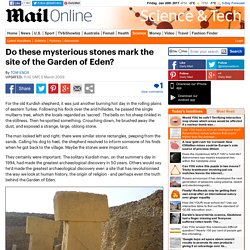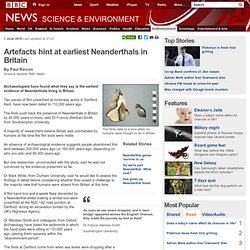

Peru. Surveys. Stonehenge. Do these mysterious stones mark the site of the Garden of Eden? By Tom Knox Updated: 11:10 GMT, 5 March 2009 For the old Kurdish shepherd, it was just another burning hot day in the rolling plains of eastern Turkey.

Following his flock over the arid hillsides, he passed the single mulberry tree, which the locals regarded as 'sacred'. The bells on his sheep tinkled in the stillness. Then he spotted something. The man looked left and right: there were similar stone rectangles, peeping from the sands. They certainly were important. The site has been described as 'extraordinary' and 'the most important' site in the world A few weeks after his discovery, news of the shepherd's find reached museum curators in the ancient city of Sanliurfa, ten miles south-west of the stones. They got in touch with the German Archaeological Institute in Istanbul.
As he puts it: 'As soon as I got there and saw the stones, I knew that if I didn't walk away immediately I would be here for the rest of my life.' Schmidt stayed. So far, so remarkable. And so, paradise was lost. Artefacts hint at earliest Neanderthals in Britain. 1 June 2010Last updated at 21:01 By Paul Rincon Science reporter, BBC News The flints date to a time when no humans were thought to be in Britain Archaeologists have found what they say is the earliest evidence of Neanderthals living in Britain.

Two pieces of flint unearthed at motorway works in Dartford, Kent, have now been dated to 110,000 years ago. The finds push back the presence of Neanderthals in Britain by 40,000 years or more, said Dr Francis Wenban-Smith, from Southampton University. A majority of researchers believe Britain was uninhabited by humans at the time the flint tools were made. An absence of archaeological evidence suggests people abandoned this land between 200,000 years ago (or 160,000 years ago, depending on who you ask) and 65,000 years ago. But one researcher, unconnected with the study, said he was not convinced by the evidence presented so far. Continue reading the main story “Start Quote End QuoteDr Francis Wenban-SmithSouthampton University Opportunity knocks. Arqueologia - Povoamento das Americas - Imigração. Um estudo elaborado a partir da análise do DNA de 70 mil indivíduos - 1.338 originários do Brasil - afirma que a ocupação do continente americano foi feita por pelo menos dois movimentos migratórios.

O estudo, publicado nesta quinta-feira na revista eletrônica Current Biology, diz que os primeiros habitantes das Américas falavam idiomas diversos e seguiram diferentes rotas. A nova pesquisa vai contra o resultado de outro estudo publicado há quase oito meses na revista American Journal of Physical Antropology. "Antigamente, acreditava-se na hipótese de que o povoamento das Américas fosse resultado de apenas uma migração", disse à BBC Brasil o geneticista da Universidade de Pavia, no norte da Itália, Antonio Torroni. "Eu mesmo defendia essa hipótese. " "Nosso estudo revela que foram feitos dois caminhos quase concomitantes de imigração, que levaram a espalhar os paleoíndios.
" Ela indica que, antes dessa marcha empreendida há 12 mil anos, uma outra leva, bem mais antiga, chegou à América. Fossil Cities. There seems to be three stages in the physical formation of a planet’s composition; in each stage the majority its minerals are shaped by a new, additional force.

Those three forces are: physics, life, and mind. The physical influence on minerals is obvious. Until recently physics was seen as the only force in geology. Chemical reactions, heat, erosion, immense weight and pressure, and occasionally atomic forces all conspire to shape and reshape rocks. What more could happen? Recent studies suggest that most minerals present on earth today were directly or indirectly shaped by life, that wavering intangible thing. With the rise of human minds, and the widespread emergence of technology, a third geological era is arriving: the Anthropocene. A new book by Jan Zalasiewicz, a geologist from the University of Leicester, “The Earth After Us: What Legacy Will Humans Leave in the Rocks?” Firing a brick drives off the water. Regrettably, none of these ideas have been tested. What city?